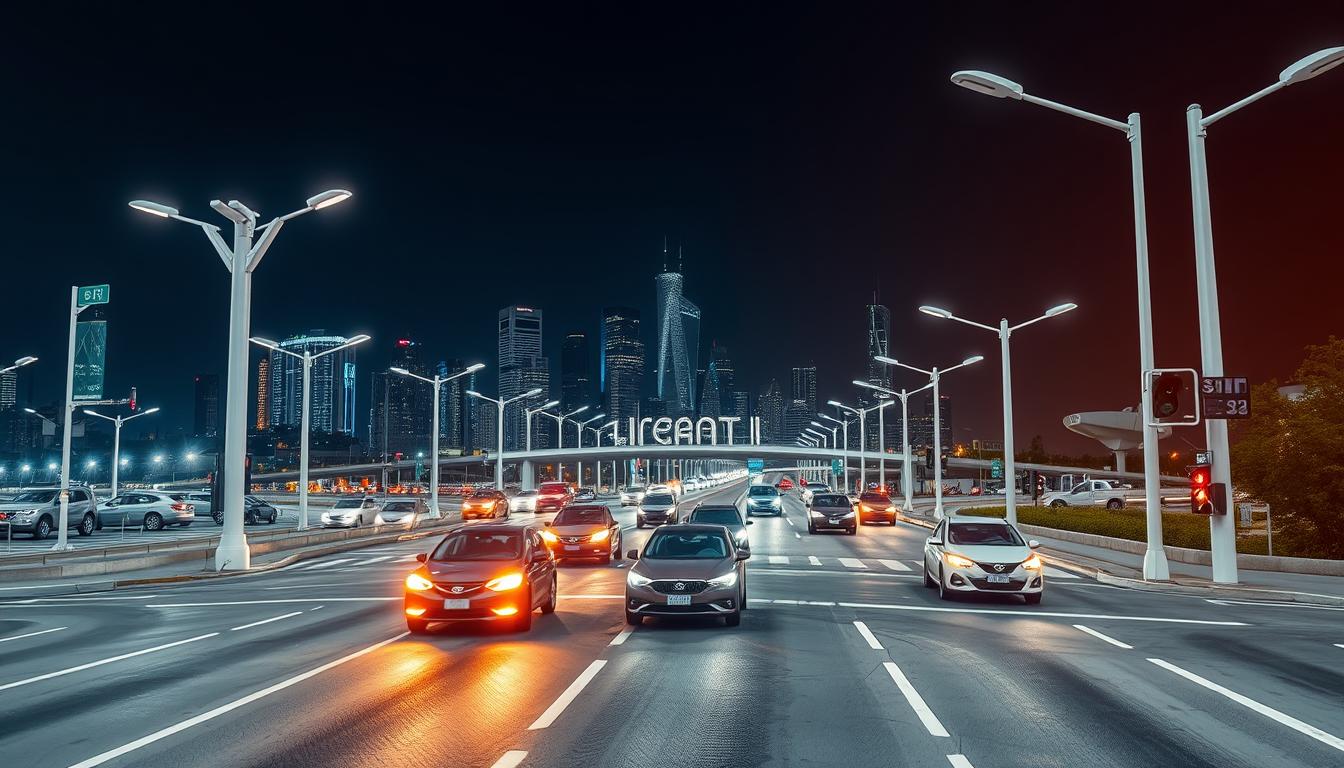On a rainy Tuesday in Tampa, a commuter tapped his brake less and smiled more. His dashboard had warned of a sudden hazard ahead, and a nearby signal adjusted to ease congestion. That brief moment showed how modern systems can change a commute.
The story is a snapshot of how vehicles and roadside equipment share information to cut crashes and calm traffic. Real-time, two-way data helps spot hazards, tune signals, and guide drivers toward safer choices.
VICAD—the link between vehicle sensing, roadside systems, cloud analytics, and governance—turns raw data into timed actions. Pilot projects in the U.S. show fewer emergency brakings and modest travel-time gains when these systems work together.

Companies like
Iottive
bring end-to-end expertise in connected sensors, BLE apps, and cloud/mobile platforms to help scale these deployments. This guide will map the key systems, real-world benefits, and the governance needed for safe development.
Key Takeaways
- Real-time data exchange links vehicles and infrastructure to improve safety and ease traffic.
- Cooperative systems like VICAD turn sensor inputs into actionable, safety-focused outcomes.
- Pilot results show measurable drops in forward collisions and emergency braking events.
- Deployment needs clear governance for privacy, encryption, and trusted data flows.
- Vendors such as
Iottive
offer end-to-end solutions for scaling deployments across cities.
The state of AI-powered V2I and IoT smart roads in the United States today
Cities and highways are upgrading to systems that sense conditions and alter signal timing in real time.
Why this matters: American road infrastructure is shifting from fixed assets to adaptive, sensor-rich platforms. Embedded sensors, connected signals, and gateways now continuously sense, compute, and coordinate movement for safer travel.

Why real-time data exchange is the new backbone of transportation systems
Real-time information between vehicles, signals, and management systems underpins safety-critical applications. Live feeds reduce surprises for drivers and help control traffic flow during peak periods.
From static roads to adaptive infrastructure: what’s changed and why it matters
Pilots show measurable gains: highway travel times improve about 10.4% and intersection queues shrink nearly 20%. Adaptive signals can cut CO2 by up to 30% and raise overall traffic efficiency by more than a third.
- Baseline assets: roadside sensors, connected signals, and vehicle gateways.
- Funding: federal grants and PPPs speed development and scale.
- Operational shift: agencies move from static timing plans to continuous, data-driven management.
Vendors such as Iottive build end-to-end solutions—pairing BLE, mobile, and cloud to link roadside devices, vehicles, and platforms for U.S. agencies. Standards alignment and workforce development remain key to citywide deployment.
V2X fundamentals: How vehicles, infrastructure, and networks communicate
V2X is the umbrella for vehicle communication with other vehicles, roadside systems, pedestrians, and cloud services. It defines how information moves and which messages get priority when seconds matter.

V2V, V2I, V2P, and V2N in practice
V2V shares speed, position, and direction for collision avoidance. NHTSA estimates V2V and V2I safety apps could eliminate or mitigate up to 80% of non‑impaired crashes, especially at busy intersections.
V2I sends green‑light speed advisories and optimized signal timing. V2P warns drivers of pedestrians and cyclists via phones and wearables. V2N links vehicles to cloud systems for rerouting and fleet coordination.
Where edge analytics amplify situational awareness
Edge computing lives in vehicle ECUs and roadside units to fuse sensor streams and act on real‑time data. Ultra‑reliable, low‑latency channels carry safety messages with strict priorities so warnings reach drivers in time.
- Message types: status, warning, and control — prioritized by time sensitivity.
- Perception boost: shared intent extends line‑of‑sight and aids cooperative maneuvers.
- Data governance: authentication, anonymization, and minimal fields keep exchanges safe.
Iottive’s BLE app development and cloud/mobile integration enable secure edge‑to‑cloud data exchange for pilots and production programs that test these systems in real traffic.
AI V2I connectivity, IoT smart roads, autonomous mobility integration
When on-vehicle sensors meet roadside processing and cloud analytics, detection confidence rises and false alerts fall.

Core components: sensors, roadside units, traffic signals, and cloud platforms
Perception layers use cameras, radar, and LiDAR to gather local views. Roadside units handle short‑range processing and messaging.
Signals and cloud link local insights to citywide optimization and operator dashboards for real‑time management.
VICAD architecture: Vehicle, Infrastructure, Cloud, and Data working together
The VICAD model syncs on‑board intelligence with field sensing and cloud analytics. This mix boosts detection of occluded hazards and improves decision quality.
“Merging infrastructure sensing with vehicle perception adds a vital layer of redundancy for intersection safety.”
From ADAS to cooperative driving: enabling safer autonomous driving
Shared intent messages help vehicles negotiate merges and unprotected turns. Operators use dashboards to monitor KPIs, send updates, and manage device health.
| Layer | Function | Benefit |
|---|---|---|
| Perception | Cameras, radar, LiDAR | Hazard detection, blind‑spot coverage |
| Edge units | Local fusion & messaging | Low latency warnings |
| Signal control | Adaptive timing | Reduced delay, clearer routing |
| Cloud | Analytics & dashboards | Citywide optimization, OTA updates |
Iottive
designs custom platforms that connect sensors, RSUs, and cloud services with BLE and mobile apps to support pilots and production deployments.
5G, DSRC, and C‑V2X: The communications stack enabling real-time responsiveness
Modern transport relies on layered wireless links to deliver life‑critical alerts in milliseconds. The communications stack blends 5G and short‑range radio protocols to move information that prevents collisions and clears intersections.

Why latency matters: millisecond‑level delays separate a near miss from a crash. Short‑range radios like DSRC and IEEE 802.11p offer predictable range and low delay for intersection use. C‑V2X delivers broader coverage and longer reach but needs spectrum and vendor alignment.
5G brings ultra‑low latency and high bandwidth for real time HD map updates, remote operation, and scaling connected devices in dense urban canyons. Edge preprocessing prioritizes safety messages while the cloud aggregates data for learning and system development.
Interoperability and security: regions use ITS‑G5, C‑V2X, and IEEE variants, so multi‑mode gateways ease transitions. Architectures must include mutual authentication and signed messages to keep networks and infrastructure trusted during peak traffic and emergencies.
- DSRC vs C‑V2X: spectrum, range, and deployment trade‑offs for city vs corridor use.
- Edge + cloud: prioritize safety messages at the edge, aggregate in cloud for updates.
- Cybersecurity: authentication, message signing, and robust failover across systems.
Iottive
integrates mobile and cloud services with roadside communication stacks to support DSRC and C‑V2X pilots and enable scalable rollouts.
AI and data pipelines: Turning sensor streams into decisions in real time
Sensor streams must be turned into clear actions within fractions of a second to prevent crashes and ease delays. The end-to-end pipeline ingests, cleans, fuses, infers, decides, and acts across vehicle, roadside edge, and cloud tiers.

Edge vs. cloud analytics for time-critical safety and traffic flow
Edge handles sub-100 ms safety decisions and local alerts. It filters and forwards key information to the cloud.
Cloud supports fleet learning, long‑range optimization, and policy management. Iottive’s cloud & mobile integration links edge devices to secure data lakes and dashboards.
HD maps, predictive maintenance, and signal optimization
HD map streaming and change detection keep vehicles and signals aligned with work zones and incidents.
Predictive maintenance cuts repair costs by about 25% and spots needs up to 90% faster than manual methods.
Data governance, privacy, and public trust
“Transparent retention, minimal collection, and role-based access build citizen confidence.”
- Encrypt data in transit and at rest.
- Apply anonymization and differential privacy.
- Run audits, red-team tests, and clear public communications.
| Stage | Role | Outcome |
|---|---|---|
| Ingest & Clean | Edge/vehicle | Reduce noise, keep latency low |
| Fuse & Infer | Edge | Sub-100 ms safety alerts |
| Decide & Act | Edge/Signal | Immediate warnings, adaptive timing |
| Aggregate & Learn | Cloud | Citywide optimization, maintenance planning |
Proven benefits: Safety, efficiency, and sustainability outcomes you can measure
Real-world trials reveal that targeted alerts and adaptive signal timing drive measurable safety and energy wins on busy corridors.
Crash prevention and hazard detection in busy intersections
Targeted warnings and anomaly detection reduce conflict points where pedestrians, bikes, and vehicles meet. Tampa’s pilot cut forward collision conflicts by 9% and emergency braking incidents by 23%.
Improved traffic flow, reduced idling, and lower emissions
Adaptive signals smooth arrivals and enable platoons, lowering stops and delays. The same pilot showed travel times fell by 2.1% and idle minutes by 1.8%.
Optimized timing can cut emissions by roughly 32–40%, which trims fuel consumption and greenhouse gases while easing driver stress.
Energy optimization and EV charging strategies on connected corridors
Systems that steer electric vehicles to available chargers and to off‑peak windows reduce grid strain and improve charge access. Energy-aware lighting and roadside equipment can dim or shift schedules to cut operating costs.
“Outcome-based KPIs — crash surrogates, person-throughput, idle minutes, and emissions per mile — help cities measure real progress.”
- Quantify intersection safety gains from alerts and anomaly detection.
- Link adaptive control to fewer stops, smoother traffic flow, and emission drops.
- Reduce fuel consumption, tire/brake wear, and improve transit on-time performance.
- Steer electric vehicles to chargers and off-peak windows to balance the grid.
- Use energy-aware lighting to trim operational cost and emissions.
Iottive’s end-to-end solutions support energy-aware applications and electric vehicle integrations across roadside and mobile apps, making these outcomes measurable and repeatable.
Real-world case studies and pilots shaping deployment
Field pilots reveal how coordinated signaling and in-vehicle alerts change driver behavior at busy intersections.
Tampa connected vehicle pilot: signal prioritization and conflict reduction
Architecture and message sets: Tampa’s THEA pilot linked vehicle beacons and roadside signal controllers to prioritize phases and send timely warnings. Message logic gave proactive green timing to reduce conflict points and warn drivers of potential hazards.
Metrics: The deployment yielded 9% fewer forward collision conflicts, 23% fewer emergency braking events, 2.1% reduced travel time, 1.8% lower idle time, and 56% participant satisfaction.
Bus signal priority improved transit reliability while keeping cross‑traffic safe. Operators used dashboards to track performance and validate outcomes.
Michigan lessons: unified datasets and common languages
Michigan pilots stressed model alignment, shared semantics, and governance to avoid vendor lock‑in. Agencies adopted common schemas, API contracts, and phased testing to speed development and cut integration delays.
“Standardized data and repeatable testing protocols are the glue for scale.”
- Translate Tampa patterns into reusable data schemas and API contracts.
- Validate systems in realistic field conditions before citywide rollout.
- Use BLE apps and cloud reporting to link participants, verify KPIs, and support pilot-to-scale execution.
Challenges to scale: Reliability, security, bandwidth, and power constraints
Large-scale rollouts stress networks in ways that lab tests rarely reproduce, especially under peak traffic and severe weather.
Communication reliability in dense urban settings and adverse weather
Urban canyons and heavy rain create multipath, blockage, and fading that hurt message delivery. Antenna diversity, sectorized radios, and cellular fallback reduce outages.
Designers should layer short‑range links with wide‑area links and plan for physical obstructions. This mix preserves safety messages when the environment degrades.
Cybersecurity, encryption, and authentication for resilient networks
Security must be baked in: a stack of PKI, certificate revocation, signed messages, and zero‑trust access keeps roadside and cloud edges trusted.
Regular certificate rotation, logging, and tamper detection help operations spot compromises and restore service fast.
Bandwidth, latency, and edge strategies for peak-load performance
Prioritize safety and control messages during spikes and compress or delay telemetry that is non‑critical. Dynamic bandwidth allocation and QoS rules maintain low latency for urgent alerts.
Edge buffering and local decision logic allow systems to act for seconds or minutes when backhaul drops, avoiding degraded safety at intersections.
Energy‑efficient devices and maintenance at roadside scale
Energy tactics lower OPEX: solar‑assisted cabinets, duty‑cycled sensors, and efficient compute modules extend field life. Remote diagnostics and OTA updates cut truck rolls.
Iottive
designs low‑power IoT hardware and secure mobile/cloud pipelines to minimize maintenance cycles and protect sensitive mobility data.
“Resilience is as much about lifecycle management as it is about peak performance.”
- RF mitigation: antenna diversity and fallback paths for urban blockage.
- Security stack: PKI, revocation lists, signed messages, and zero‑trust policies.
- Bandwidth tactics: prioritize safety, compress telemetry, and use edge buffering.
- Lifecycle ops: remote health checks, OTA, and spare‑parts planning at scale.
Policy, funding, and PPPs: Accelerating smart infrastructure adoption
Public trust and clear liability rules often determine whether a pilot grows into citywide development.
Federal grants and programmatic funding map the first steps for infrastructure upgrades. BUILD grants and corridor investments, such as the I‑70 Mountain Corridor private upgrades, show how public dollars plus private capital speed deployment and reduce taxpayer burden.
Federal grants, standards, and adaptive regulatory frameworks
Standards enable cross-vendor interoperability, secure networks, and long-term maintainability. Adaptive regulation that shortens approval cycles can cut repair and rollout costs by roughly 25%.
Public-private partnerships and economic development impacts
PPPs blend public oversight with private innovation to fund large-scale development. These models create construction jobs, attract tech firms, and improve logistics efficiency.
Liability, insurance, and building public confidence
Clear liability allocation helps insurers price risk for vehicles and field equipment. New insurance approaches are emerging as a key part of the market, which some forecasts place near $1.5T by 2030.
- Map funding avenues to safety, efficiency, and sustainability outcomes.
- Use standards to protect security and long-term management.
- Structure PPPs to de-risk pilots and document ROI through phased reporting.
- Engage the public with privacy policies, open dashboards, and independent audits.
“Staged pilots and transparent reporting de-risk implementation and build political will.”
Iottive
partners with agencies and OEMs to meet standards, document ROI, and de-risk implementation through staged pilots and clear reporting. That approach helps scale development while keeping data and safety central to transportation systems planning.
Implementation roadmap: From pilot to citywide autonomous mobility integration
A phased approach reduces risk, limits cost overruns, and speeds measurable benefits.
Start with readiness: run an asset and data readiness review to match architectures to corridor priorities and budgets.
Align stakeholders early—transportation agencies, vendors, and community groups—so governance, procurement, and privacy policies move in step.
Pilot design and KPIs
Co‑create MVP pilots with clear safety and efficiency KPIs such as conflict surrogates, idle‑time reduction, and citizen feedback loops.
Use unified datasets and common communication languages to avoid vendor lock‑in and speed validation, as demonstrated in Michigan pilots.
Scaling and operations
Define iteration cadence, scaling thresholds, and interoperability tests before expansion. This prevents delays that can raise costs by up to 150% per lane annually.
Establish 24/7 management for incident response, device health, and configuration. Integrate continuous improvement with model updates, firmware patches, and seasonal playbooks.
- Align procurement, privacy compliance, and workforce training with long‑term sustainability.
- Document KPIs and handoffs so operations and vendors share one source of truth.
“Pilot programs refine strategy before larger rollouts; clear KPIs and managed services turn lessons into repeatable deployment.”
Iottive
offers readiness assessments, architecture recommendations, MVP pilots, KPI frameworks, and managed services to operate and evolve these systems and vehicle‑to‑field programs.
Where V2I meets industries: Healthcare, logistics, and smart city ecosystems
Hospitals, freight depots, and city control centers now rely on vehicle-to-field links to speed response and cut delays. These cross-sector ties let operators clear corridors, sync intersections, and move goods with fewer stops.
Healthcare and emergency response: Preemption and precision routing
Emergency preemption clears lanes and holds cross traffic so ambulances and fire services reach incidents faster. Precision routing factors in closures, weather, and demand to reduce response times and improve outcomes.
Freight and fleet: Platooning, fuel consumption, and operational efficiency
Platooning stabilizes headways, lowers drag, and trims fuel consumption for long hauls. Fleet telematics linked to city signals cut dwell at loading docks and boost schedule reliability.
Example: Iottive connects emergency vehicles, fleet apps, and roadside controllers via BLE and cloud APIs to support preemption, routing, and telematics. Shared data across agencies and private operators unlocks network-level gains in traffic flow and overall efficiency for transportation systems in U.S. cities.
Why Iottive for end-to-end IoT/AIoT smart road solutions
Iottive
delivers complete systems that move from sensors to apps with clear KPIs and rapid pilots. Our work pairs rugged field devices, BLE-enabled gateways, and cloud platforms to make data useful for operations teams and vendors.
Our expertise: BLE app development, cloud & mobile integration, custom IoT products
We build BLE apps and mobile clients that link vehicles and field devices to secure cloud services. Our engineering teams deliver firmware, backend APIs, and mobile UX focused on reliability and fast deployment.
From sensors to apps: Vehicle connectivity and data exchange at scale
Standards-based APIs and interoperable architectures let agencies scale device fleets and networks. We operationalize vehicle connectivity, encrypted data pipelines, and certificate management to meet agency and OEM requirements.
Contact us to accelerate deployment
Services include discovery workshops, proof-of-concept builds, and phased citywide rollouts. Reach us:
www.iottive.com | sales@iottive.com
| Offering | Benefit | Use Case |
|---|---|---|
| Rugged sensors & gateways | Field reliability, low OPEX | Corridor sensing, EV charging detection |
| BLE & mobile apps | Driver alerts, fleet apps | Emergency preemption, fleet routing |
| Cloud & APIs | Analytics, KPI reporting | Pilot validation, ROI storytelling |
Conclusion
Real‑world programs tie local sensing to signal logic, turning raw observations into faster, safer traffic responses. Pilots show clear wins: fewer conflicts and emergency brakings in Tampa, shorter travel and idle times, lower queues, and emissions down as much as 30% in tested corridors.
Standards, low‑latency links, and governed data pipelines make deployments resilient and trustworthy. Funded pilots and PPPs unlock scale while unified datasets and encryption keep systems reliable and auditable.
Assess, pilot, prove KPIs, and scale with continuous improvement and transparent reporting.
Iottive
stands ready to partner across strategy, engineering, and operations to deliver measurable safety, efficiency, and sustainability outcomes. Contact: www.iottive.com | sales@iottive.com
FAQ
What is the role of real-time data exchange in modern transportation systems?
Real-time data exchange enables vehicles and roadside systems to share timely information about traffic, road conditions, signal status, and hazards. This continuous flow helps traffic managers optimize signal timing, reduces congestion, and supports faster emergency response. By combining sensor feeds, edge analytics, and cloud platforms, cities can improve safety and energy efficiency while lowering fuel consumption and emissions.
How do vehicles, infrastructure, and networks communicate in a V2X setup?
Vehicles communicate with each other, with roadside units, with pedestrians, and with network services using a layered communication stack such as 5G, DSRC, or C‑V2X. Messages include position, speed, and intent for collision avoidance and signal phase information for smoother intersections. Edge computing and machine learning amplify situational awareness by processing local sensor data before sending summarized insights to the cloud.
What are the key components of a roadside system that supports connected and cooperative driving?
Core components include roadway sensors (cameras, radar, LIDAR), roadside units and traffic signal controllers, centralized cloud platforms, and APIs for vehicle and fleet integration. Together these parts collect telemetry, run analytics, and deliver actionable alerts to vehicles and traffic operations centers, enabling cooperative functions like signal priority and platooning.
How does edge analytics differ from cloud analytics for time-critical decisions?
Edge analytics processes data close to the source, minimizing latency for safety-critical functions such as collision avoidance and emergency vehicle preemption. Cloud analytics handles longer-term tasks like HD map updates, predictive maintenance, and city-wide traffic optimization. A hybrid pipeline balances immediate responsiveness with scalable model training and historical trend analysis.
What communication technologies enable ultra-low latency for collision avoidance and alerts?
Ultra-low latency is achieved using cellular networks such as 5G and dedicated short-range communications (DSRC), or cellular-based C‑V2X. These options support rapid message delivery, high reliability, and prioritized traffic for public safety. Network slicing and edge compute also help guarantee timely performance during peak loads.
How do connected systems improve energy use and EV charging integration?
Connected infrastructure optimizes traffic flow to reduce idling and stop-and-go conditions, cutting fuel consumption and emissions. For electric vehicles, platforms can coordinate charging schedules, provide route-aware range predictions, and manage smart charging stations to balance grid demand and reduce peak loads, enhancing sustainability and operational efficiency.
What measurable safety benefits have pilots demonstrated in the United States?
Pilots like the Tampa connected vehicle program have shown reduced signal conflicts and faster emergency vehicle clearance. Michigan pilots have highlighted the value of unified datasets for consistent messaging. These tests report fewer near-misses, better intersection awareness, and improved response times—translating to lower crash risk and better public safety outcomes.
What are the main cybersecurity and privacy concerns for connected road systems?
Key concerns include secure message authentication, encryption, and device hardening to prevent spoofing or tampering. Data governance policies must control access, protect personal information, and maintain transparency to build public trust. Regular audits, patching, and multi-factor authentication help maintain resilience against attacks.
How do standards and interoperability affect regional deployments?
Interoperability ensures vehicles and roadside equipment from different vendors work together across cities and states. Aligned standards reduce integration costs and simplify scaling. Regional coordination of protocols, message sets, and certification processes helps avoid fragmentation and speeds wider adoption.
What factors should cities consider when moving from pilot projects to citywide deployment?
Cities should perform readiness assessments, align stakeholders, select scalable architectures, and define KPIs for safety, congestion, and emissions. Pilot design must include iterative scaling, maintenance plans, and operations teams for real-time management. Public-private partnerships and sustainable funding models are also critical for long-term success.
How can freight and fleet operators benefit from connected road infrastructure?
Freight and fleet operators gain from platooning, optimized routing, reduced fuel consumption, and predictive maintenance. Real-time data exchange improves ETA accuracy, lowers idle time, and boosts operational efficiency. Integration with telematics and cloud services helps fleets scale these benefits across routes and terminals.
What role do public-private partnerships and federal funding play in deployment?
Federal grants and adaptive regulations can accelerate infrastructure upgrades by lowering upfront costs. Public-private partnerships provide technical expertise, shared investment, and faster procurement. Together they support economic development, encourage innovation, and spread risk while building public confidence in new systems.
What are common technical challenges to scaling connected road solutions?
Common challenges include maintaining communication reliability in dense urban areas and adverse weather, ensuring sufficient bandwidth and low latency, and powering roadside devices efficiently. Solutions include redundancy, edge strategies for peak loads, efficient device design, and robust encryption to meet security and performance needs.
How do data governance and transparency influence public acceptance?
Clear policies on data use, retention, and anonymization build trust. Open communication about how data improves safety and reduces emissions helps gain public buy-in. Independent oversight, privacy safeguards, and accessible reporting on outcomes reinforce accountability and foster acceptance of connected services.
How can cities measure the ROI of connected infrastructure projects?
Cities can track metrics such as crash rates, emergency response times, vehicle hours of delay, fuel consumption, and emissions. Measuring changes in traffic throughput, signal efficiency, and EV charging utilization provides quantifiable evidence of safety, environmental, and economic benefits to justify continued investment.